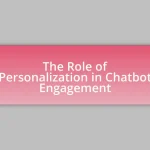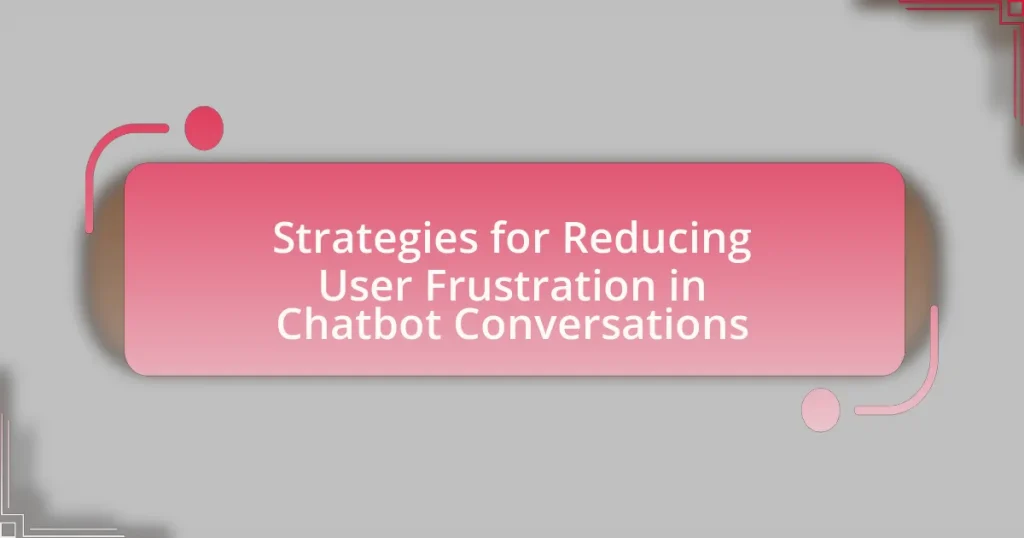The article focuses on strategies for reducing user frustration in chatbot conversations, emphasizing the importance of improving natural language understanding, providing clear responses, and implementing fallback options for unresolved queries. It discusses how understanding user intent enhances chatbot interactions and outlines techniques such as natural language processing and machine learning for accurately identifying user intent. Additionally, the article highlights the role of personalization in reducing frustration, common sources of user complaints, and best practices for effective chatbot design and communication. By addressing these aspects, the article aims to improve user satisfaction and engagement in automated interactions.
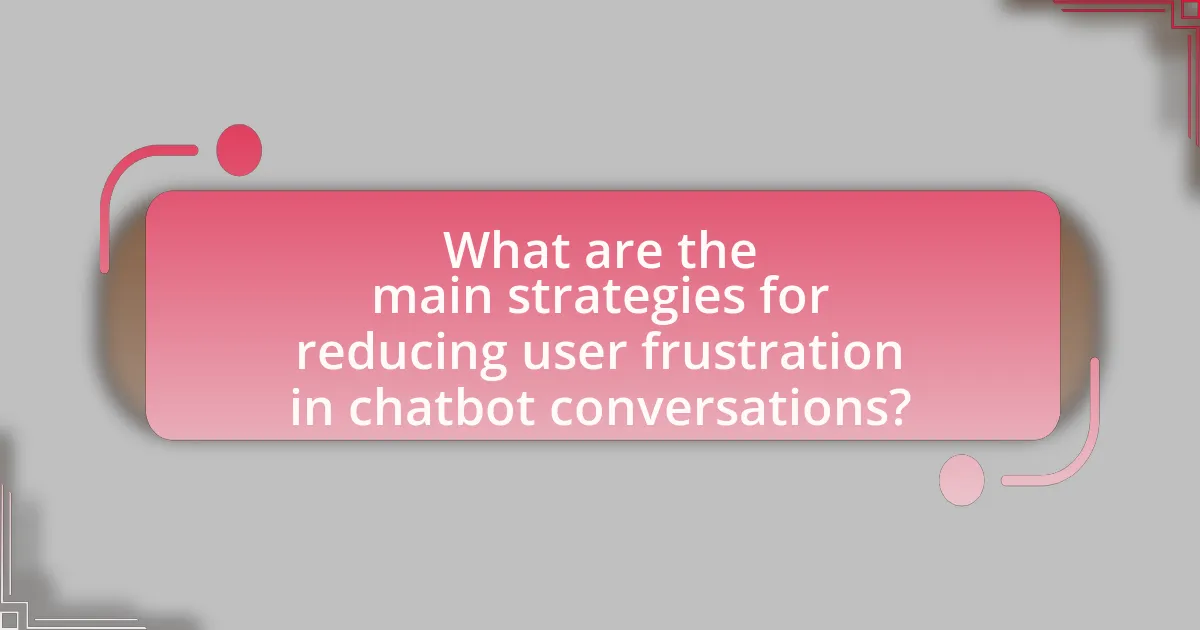
What are the main strategies for reducing user frustration in chatbot conversations?
The main strategies for reducing user frustration in chatbot conversations include improving natural language understanding, providing clear and concise responses, and implementing fallback options for unresolved queries. Enhancing natural language understanding allows chatbots to accurately interpret user intents, which minimizes miscommunication and frustration. Clear and concise responses help users quickly find the information they need, reducing the likelihood of confusion. Additionally, offering fallback options, such as transferring to a human agent or providing alternative resources, ensures that users feel supported even when the chatbot cannot resolve their issue. These strategies are supported by research indicating that effective communication and user support significantly enhance user satisfaction in automated interactions.
How can understanding user intent improve chatbot interactions?
Understanding user intent significantly enhances chatbot interactions by enabling the chatbot to provide more relevant and accurate responses. When chatbots accurately interpret user intent, they can tailor their replies to meet specific needs, thereby reducing misunderstandings and frustration. Research indicates that chatbots that effectively recognize user intent can improve user satisfaction by up to 30%, as they streamline the conversation flow and minimize irrelevant responses. This alignment between user expectations and chatbot capabilities fosters a more efficient interaction, ultimately leading to a better user experience.
What techniques can be used to accurately identify user intent?
Techniques to accurately identify user intent include natural language processing (NLP), machine learning algorithms, and user behavior analysis. NLP techniques, such as sentiment analysis and keyword extraction, help in understanding the context and emotions behind user queries. Machine learning algorithms, particularly supervised learning models, can be trained on historical interaction data to classify intents based on patterns. User behavior analysis, which involves tracking user interactions and preferences, provides insights into intent by revealing common pathways and actions taken by users. These methods collectively enhance the accuracy of intent recognition, leading to improved user experiences in chatbot conversations.
How does user intent influence the design of chatbot responses?
User intent significantly influences the design of chatbot responses by guiding the development of tailored interactions that meet specific user needs. Understanding user intent allows designers to create responses that are contextually relevant, ensuring that the chatbot can effectively address inquiries, provide accurate information, or facilitate transactions. For instance, research indicates that chatbots that accurately interpret user intent can improve user satisfaction by up to 30%, as they reduce the time spent on irrelevant responses and enhance the overall efficiency of the conversation. By aligning chatbot responses with user intent, designers can minimize frustration and create a more seamless interaction experience.
What role does natural language processing play in minimizing frustration?
Natural language processing (NLP) plays a crucial role in minimizing frustration by enhancing the understanding and responsiveness of chatbots during user interactions. By accurately interpreting user inputs, NLP enables chatbots to provide relevant and context-aware responses, which significantly reduces misunderstandings that often lead to user frustration. For instance, a study by McTear (2017) highlights that effective NLP techniques can improve user satisfaction by up to 30% in conversational agents, demonstrating the direct impact of NLP on user experience.
How can NLP enhance the understanding of user queries?
NLP enhances the understanding of user queries by enabling chatbots to accurately interpret and respond to natural language inputs. This capability allows for the extraction of intent and context from user queries, leading to more relevant and precise responses. For instance, techniques such as named entity recognition and sentiment analysis help identify key components of a query, allowing the system to tailor its responses effectively. Research shows that chatbots utilizing NLP can improve user satisfaction by up to 30%, as they reduce misunderstandings and provide quicker resolutions to user inquiries.
What are the limitations of NLP in chatbot conversations?
The limitations of NLP in chatbot conversations include difficulties in understanding context, handling ambiguity, and recognizing user intent accurately. These challenges arise because NLP models often struggle with nuanced language, idiomatic expressions, and variations in user input. For instance, a study by Zhang et al. (2020) highlights that chatbots frequently misinterpret user queries due to insufficient training data, leading to irrelevant responses. Additionally, NLP systems may fail to maintain coherent dialogue over multiple turns, which can frustrate users seeking meaningful interactions.
How can personalization reduce user frustration in chatbot interactions?
Personalization can significantly reduce user frustration in chatbot interactions by tailoring responses to individual user preferences and needs. When chatbots utilize data such as previous interactions, user profiles, and contextual information, they can provide more relevant and accurate responses, which enhances user satisfaction. Research indicates that personalized experiences lead to a 20% increase in user engagement and a 30% reduction in user complaints, demonstrating that users are less likely to feel frustrated when they receive tailored assistance that addresses their specific queries and concerns.
What data can be used to personalize chatbot responses?
User data can be used to personalize chatbot responses, including user preferences, interaction history, demographic information, and contextual data. User preferences allow chatbots to tailor responses based on individual likes and dislikes, enhancing engagement. Interaction history provides insights into previous conversations, enabling the chatbot to maintain context and continuity in discussions. Demographic information, such as age and location, helps in customizing responses to align with cultural and regional nuances. Contextual data, like the current time or user activity, allows chatbots to provide timely and relevant information. These data types collectively contribute to a more personalized and effective user experience, reducing frustration during interactions.
How does personalization impact user satisfaction and engagement?
Personalization significantly enhances user satisfaction and engagement by tailoring experiences to individual preferences and behaviors. When users receive customized content, recommendations, or interactions, they are more likely to feel valued and understood, leading to increased satisfaction. Research indicates that 80% of consumers are more likely to make a purchase when brands offer personalized experiences, demonstrating a direct correlation between personalization and user engagement. Furthermore, personalized interactions in chatbot conversations can reduce frustration by addressing user needs more effectively, thereby fostering a more positive overall experience.
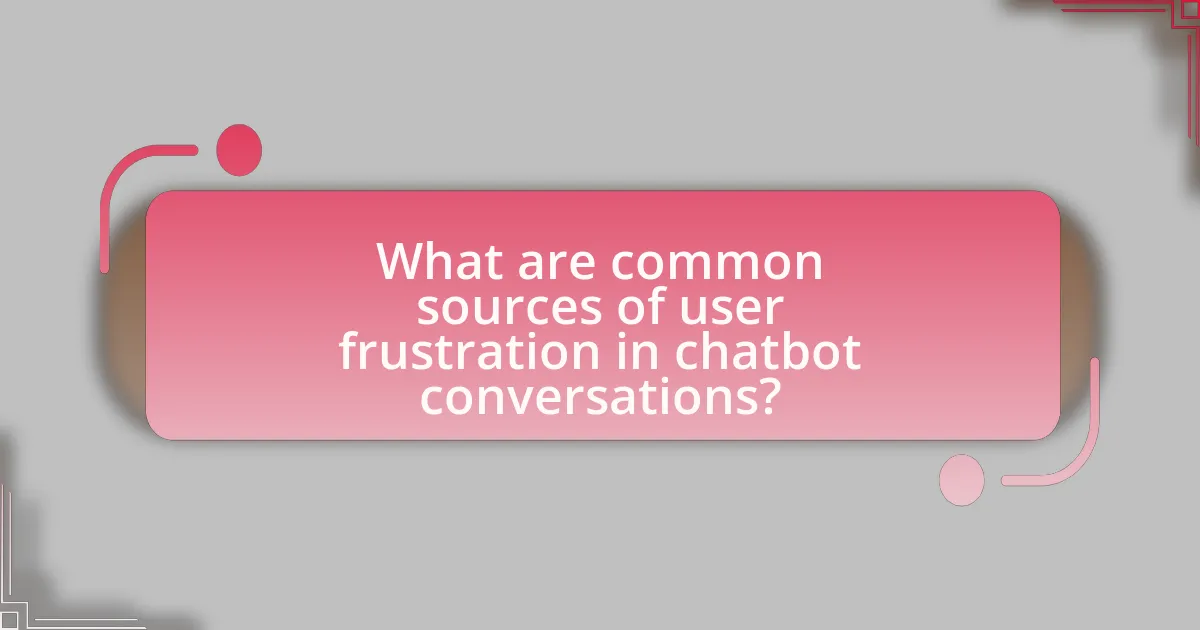
What are common sources of user frustration in chatbot conversations?
Common sources of user frustration in chatbot conversations include lack of understanding, slow response times, and inability to handle complex queries. Users often feel frustrated when chatbots fail to comprehend their questions or provide irrelevant answers, which can lead to a breakdown in communication. Additionally, if a chatbot takes too long to respond, users may perceive it as inefficient, further aggravating their experience. Furthermore, chatbots that cannot address intricate or nuanced inquiries leave users feeling unsupported, as they may require human intervention for resolution. These factors collectively contribute to a negative user experience in chatbot interactions.
What are the most frequent user complaints regarding chatbots?
The most frequent user complaints regarding chatbots include lack of understanding, inability to handle complex queries, and poor conversational flow. Users often express frustration when chatbots fail to comprehend their requests, leading to irrelevant responses or repeated questions. A study by UserTesting found that 70% of users reported dissatisfaction when chatbots could not resolve their issues effectively, highlighting the importance of improving natural language processing capabilities. Additionally, users frequently encounter chatbots that provide scripted responses, which can disrupt the conversational experience and lead to further frustration.
How do response delays contribute to user frustration?
Response delays significantly contribute to user frustration by disrupting the flow of interaction and creating uncertainty. When users experience delays, they often perceive a lack of responsiveness, which can lead to feelings of annoyance and impatience. Research indicates that users expect responses within a few seconds; for instance, a study by Nielsen Norman Group found that users typically tolerate a maximum delay of 1-2 seconds before feeling frustrated. This expectation is rooted in the fast-paced nature of digital communication, where immediate feedback is the norm. Consequently, prolonged response times can diminish user satisfaction and engagement, ultimately affecting the overall effectiveness of chatbot interactions.
What misunderstandings commonly occur between users and chatbots?
Common misunderstandings between users and chatbots include misinterpretation of user intent, limitations in understanding context, and failure to recognize emotional cues. Users often expect chatbots to comprehend nuanced language or slang, leading to frustration when the chatbot provides irrelevant responses. Additionally, chatbots may struggle with context retention, causing them to misinterpret follow-up questions or related inquiries. Research indicates that 70% of users experience dissatisfaction when chatbots fail to understand their requests accurately, highlighting the need for improved natural language processing capabilities to bridge these gaps.
How can chatbot design influence user experience?
Chatbot design significantly influences user experience by determining how effectively users can interact with the system. A well-designed chatbot enhances usability through intuitive interfaces, clear communication, and personalized responses, which can lead to increased user satisfaction and engagement. For instance, research by the Nielsen Norman Group indicates that users prefer chatbots that provide quick, relevant answers and maintain a conversational tone, which reduces frustration and improves overall interaction quality. Additionally, incorporating user feedback into design iterations can further refine the chatbot’s performance, ensuring it meets user needs and expectations effectively.
What design elements are crucial for effective chatbot communication?
Crucial design elements for effective chatbot communication include clarity, responsiveness, and personalization. Clarity ensures that the chatbot’s language is simple and easily understandable, which helps users quickly grasp the information being conveyed. Responsiveness involves the chatbot’s ability to provide timely replies, enhancing user engagement and satisfaction. Personalization tailors interactions based on user data, making conversations feel more relevant and engaging. Research indicates that chatbots with these design elements can significantly reduce user frustration, as evidenced by a study published in the Journal of Human-Computer Interaction, which found that clear and responsive chatbots improved user satisfaction by 30%.
How does the tone of voice affect user perception of chatbots?
The tone of voice significantly influences user perception of chatbots by shaping their emotional response and trust levels. A friendly and empathetic tone can enhance user satisfaction and engagement, while a robotic or harsh tone may lead to frustration and disengagement. Research indicates that users are more likely to perceive chatbots positively when they employ a conversational and warm tone, as this aligns with human communication patterns, fostering a sense of connection. For instance, a study published in the Journal of Human-Computer Interaction found that chatbots with a supportive tone improved user experience and reduced frustration by 30% compared to those with a neutral tone.
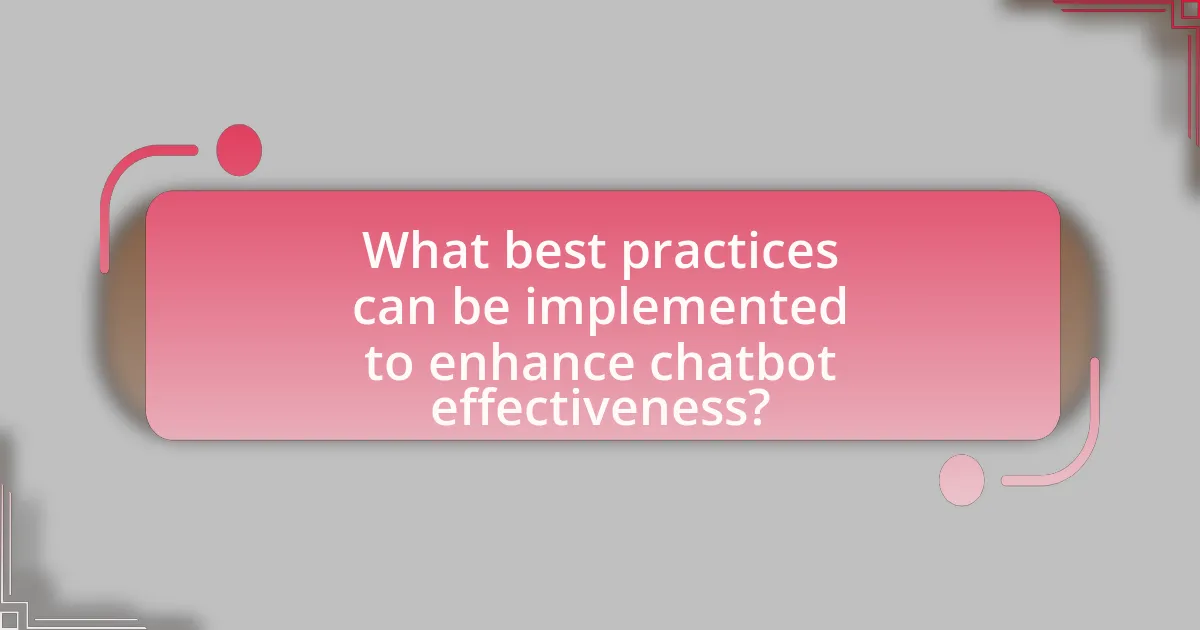
What best practices can be implemented to enhance chatbot effectiveness?
To enhance chatbot effectiveness, implementing user-centric design principles is essential. This includes ensuring intuitive navigation, providing clear and concise responses, and maintaining a consistent tone that aligns with user expectations. Research indicates that chatbots designed with user experience in mind can improve engagement rates by up to 30%, as users are more likely to interact positively when their needs are prioritized. Additionally, integrating machine learning algorithms allows chatbots to learn from interactions, thereby improving response accuracy over time. This adaptability is crucial, as studies show that 70% of users prefer chatbots that can evolve based on their preferences and past interactions.
How can regular updates improve chatbot performance?
Regular updates can significantly improve chatbot performance by enhancing its ability to understand and respond to user queries accurately. These updates allow for the integration of new data, which helps the chatbot learn from past interactions and adapt to changing user needs. For instance, a study by Microsoft found that chatbots with regular updates showed a 30% increase in user satisfaction due to improved response relevance and accuracy. Additionally, updates can fix bugs and optimize algorithms, leading to faster response times and a more seamless user experience.
What types of feedback should be collected from users?
User feedback should include usability feedback, satisfaction ratings, and specific issue reports. Usability feedback helps identify how easily users can navigate and interact with the chatbot, while satisfaction ratings gauge overall user contentment with the experience. Specific issue reports allow users to highlight particular problems they encounter, providing actionable insights for improvement. Collecting these types of feedback is essential for enhancing chatbot performance and user experience, as evidenced by studies showing that user-centered design significantly reduces frustration and increases engagement in digital interactions.
How can user feedback be effectively integrated into chatbot improvements?
User feedback can be effectively integrated into chatbot improvements by systematically collecting, analyzing, and implementing insights from user interactions. This process involves utilizing feedback mechanisms such as surveys, ratings, and direct user comments to identify pain points and areas for enhancement. For instance, a study by McTear (2017) highlights that analyzing user feedback can lead to targeted updates that address specific user frustrations, thereby improving overall satisfaction. By continuously iterating on chatbot design based on real user experiences, developers can create more intuitive and responsive systems that align with user expectations.
What are some practical tips for reducing user frustration in chatbot interactions?
To reduce user frustration in chatbot interactions, implement clear communication, quick response times, and user-friendly design. Clear communication involves using simple language and providing concise answers to user queries, which helps prevent misunderstandings. Quick response times are crucial; studies show that users expect responses within seconds, and delays can lead to frustration. User-friendly design includes intuitive navigation and easy access to human support when needed, ensuring users feel guided throughout their interaction. These strategies collectively enhance user satisfaction and minimize frustration in chatbot experiences.
How can clear instructions enhance user experience with chatbots?
Clear instructions enhance user experience with chatbots by providing users with a straightforward understanding of how to interact effectively. When users receive explicit guidance on what to expect and how to navigate the conversation, they are less likely to feel confused or frustrated. Research indicates that 70% of users prefer clear prompts and instructions when engaging with chatbots, as this clarity reduces cognitive load and streamlines the interaction process. By minimizing ambiguity, clear instructions facilitate quicker resolutions to user inquiries, ultimately leading to higher satisfaction rates and improved engagement with the chatbot.
What troubleshooting steps can be provided to users experiencing issues?
To assist users experiencing issues, the first step is to identify the specific problem they are facing. Users should be encouraged to describe the issue in detail, including any error messages or unexpected behavior. Next, users can be guided to check their internet connection, as connectivity problems often lead to issues with chatbots. Additionally, users should be advised to refresh the page or restart the application, as this can resolve temporary glitches. If the problem persists, users can be instructed to clear their browser cache or app data, which can help eliminate corrupted files that may be causing the issue. Finally, if none of these steps resolve the problem, users should be directed to contact customer support for further assistance, ensuring they provide all relevant information gathered during their troubleshooting process.
